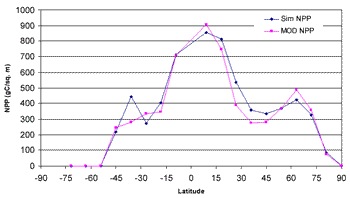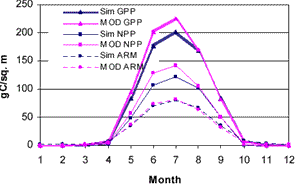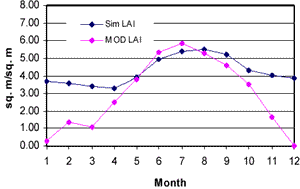| GISdevelopment.net ---> AARS ---> ACRS 2002 ---> Ecology, Environment & Carbon Cycle |
Estimation of Terrestrial
Carbon Fluxes by Integrating Remote Sensing with Ecosystem Modelling
M. K. Hazarika and Y. Yasuoka
Institute of Industrial Science, Room No. Ce-509,
University of Tokyo, 4-6-1 Komaba, Meguro-ku, Tokyo 153-8505
Tel: (81) 3-5452-6415, Fax: (81) 3-5452-6408
E-mail: manzul@iis.u-tokyo.ac.jp
Japan
M. K. Hazarika and Y. Yasuoka
Institute of Industrial Science, Room No. Ce-509,
University of Tokyo, 4-6-1 Komaba, Meguro-ku, Tokyo 153-8505
Tel: (81) 3-5452-6415, Fax: (81) 3-5452-6408
E-mail: manzul@iis.u-tokyo.ac.jp
Japan
Abstract
Sim-Cycle is a carbon cycle model which retrieves carbon dynamics of various terrestrial ecosystems. This model simulates carbon fluxes on basis of bio-physical and climatic parameters. One of the most important bio-physical parameter used in the Sim-Cycle is Leaf Area Index (LAI), which is estimated using a land cover map and climatic parameters averaged over a long period of time. LAI is a highly dynamic biophysical parameter with respect to time and space and, therefore, such an approach for its estimation may not be reliable as an input parameter for a carbon cycle model. However, remote sensing data has the potential to provide prevailing condition of such parameters and their spatial extent on the ground in a repetitive manner. Therefore, LAI derived from MODIS satellite data has been integrated with the Sim-Cycle model to generate latest scenario of carbon dynamics in global scale.
Using the original Sim-CYCLE model, global annual GPP, NPP and AR are estimated as 131.2, 62.7 and 68.5 PgCyr -1 respectively. Incorporating the MODIS-LAI in the Sim-CYCLE model, the global annual GPP, NPP and AR are re-estimated as 122.1, 59.6 and 62.5 PgCyr -1 . Results from MODIS-LAI incorporated Sim-CYCLE shows overall lower NPP estimation than original Sim-CYCLE excepts in equatorial and northern temperate boreal forest region (50ºN-60ºN).
1. Introduction
Global climate change and its cause and effects in relation to natural as well as anthropogenic activities has been a recent focus of concern within the scientific community. The average temperature of the earth’s surface, currently at about 15º C, is controlled by the gaseous composition of the atmosphere. Relatively active or greenhouse gases in the atmosphere trap the outgoing solar radiation and keep the earth warm. Emissions and re-absorption of these gases from natural ecosystem have been in equilibrium for million of years. However, this balance has been disturbed by the human activities. Consequently, the atmospheric concentrations of the greenhouse gases, which are mostly the derivatives of carbon, have been increasing rapidly and it is widely believed that higher concentration of these gases is responsible for global warming.
The carbon balance is thus a high profile issue and it carries both scientific and political significance. The question, scientifically, is what and where are the terrestrial sources and sinks of carbon, and how they change on time scales of years to decade. The question politically is what are the annual emissions of CO2 (and other green house gases) from each country? To answer all these questions, there is a need to understand the global carbon cycle process. Monitoring and modelling efforts have made it possible to understand the terms of global carbon balance in a broad perspective, but there are many uncertainties yet to be resolved. The largest uncertainties in the global carbon balance are associated with the net flux of carbon to and from terrestrial ecosystems (Houghton, 1995). However, use of satellite data with higher spatial and spectral resolution to determine the land cover and land-use in terrestrial ecosystems could significantly reduce such uncertainties .
2. Methodology
The ecosystem model used in the study is known as Sim-CYCLE developed by Ito (2000) and it has been used to retrieve the carbon dynamics of various terrestrial ecosystems in global scale. In Sim-CYCLE, terrestrial carbon dynamics are conceptualised as a five-compartment system, viz., foliage (WPF), stem (WPC), root (WPR), litter (WPL) and mineral soil (WPH) as shown in Fig. 1(a). Carbon fluxes in these compartments include gross primary production (GPP), maintenance respiration (ARM), translocation (PT), growth respiration (ARG), litterfall (LF) and heterotrophic respiration (HR).

Fig.1 Schematic diagram of Sim-CYCLE (Ito et al., 2002)
Fig. 1(b) shows the water and radiation schemes from the single leaf to canopy scale. Stomatal conductance (GS), intercellular CO2 concentration (CDICL), light-use efficiency (QE) and photosynthetic carbon assimilation (PC) are determined interactively as functions of various environmental factors such as photosynthetic photon flux density (PPFD), atmospheric CO2 concentration (CDATM), surface temperature (TG), soil-water availability (MS) and ambient vapour pressure deficit (VPD). Precipitation (PR) is partitioned into soil-water storage (MS), evaporation from soil surface (EV), evaporation from canopy (IC), transpiration from canopy (TR) and subsurface runoff (RO). Evaporation and transpiration depend on the input energy to the canopy (RNC) and soil (RNS).
Gross primary production (GPP) is the origin of all organic carbon through which atmospheric CO2 is fixed into dry matter. The scaling procedure in terms of GPP is one of the characteristics of Sim-CYCLE and GPP is estimated by the dry-matter production theory established by Monsi and Saeki (1953). Sim-CYCLE simulate carbon dynamics of individual leaves of canopy and then scale this leaf level carbon dynamics to the canopy level by accounting for variations in structure and environmental conditions within the canopy. Monsi and Saeki formulated the downward attenuation of photosynthetically active radiation (PAR) irradiance due to mutual shading of leaves in a canopy with accumulating leaf area as follows:
PPFDIN = PPFDTOP exp(-KA. LAICML)
where PPFDTOP denotes the photosynthetic photon flux density at the canopy top. The PAR irradiance attenuates exponentially with the light attenuation coefficient KA, such that a leaf underlying the cumulative leaf area index (LAICML) receives light equivalent to incident photosynthetic photon flux density (PPFDIN) on leaf surface. Daily GPP increases linearly with increasing leaf area index (LAI) and saturates to LAI when KA is high, suggesting that radiation use efficiency depends on plant productive structures (Saeki, 1960). Thus, LAI is a key parameter of Sim-CYCLE and it is defined as the one-sided green leaf area per unit ground area in broadleaf canopies and projected leaf area for needle leaf area in coniferous canopies. In Sim-CYCLE, LAI is estimated on basis of specific leaf area assumed for each biome types. However, such estimation can not be accurate for ever-changing landuse and land cover around the globe. Satellite remote sensing is the most effective means of retrieving LAI in global scale at a regular interval. Advances in remote sensing technology and radiative transfer modelling (Myneni and Ross, 1991) have improved the possibility of accurate estimation of LAI from spectral and angular dimensions of remotely sensed data. MODIS sensor in TERRA platform provides rich spectral and angular sampling of reflected radiation field for estimating LAI in global scale. MODIS-LAI product is currently being produced operationally by NASA and it is available for user community.
LAI estimated by Sim-CYCLE are first compared with the MODIS-LAI for identifying the actual biome responses and then MODIS-LAI is used to set the initial conditions and boundary values of vegetation structures for further simulation of Carbon budgets.
3. Results and Discussions
3.1 Annual carbon fluxes
Global annual GPP, NPP and AR are estimated as 131.2, 62.7 and 68.5 PgCyr-1 respectively, after reaching an equilibrium through iterative calculations, using the Sim-CYCLE model. Incorporating the MODIS-LAI into the Sim-CYCLE model as described in the methodology section, the global annual GPP, NPP and AR are re-estimated as 122.1, 59.6 and 62.5 PgCyr-1 respectively.

Fig.2 Latitudinal distribution of annual NPP
Latitudinal distribution of NPP from the original and MODIS-LAI incorporated Sim-CYCLE follows similar trends as shown in Fig.2. The highest NPP occurs around the equator with an another smaller peak occurring around 60ºN and in both cases, NPP estimated by MODIS-LAI incorporated Sim-CYCLE exceeds the NPP estimated by original Sim-CYCLE. These two regions are tropical and boreal forest respectively. Other than these two regions, overall estimation of NPP is higher in case of original Sim-CYCLE than MODIS-LAI incorporated Sim-CYCLE.
3.2 Seasonal variation of carbon fluxes
In northern temperate and boreal forest region (50ºN-60ºN) is predominantly covered by boreal forest and NPP in this region is relatively high from June to August and in these months highest temperature and precipitation occur. NPP follows an uni-modal distribution over the year (Fig.3). The maximum LAI estimated by the Sim-CYCLE is 5.51 m2 /m 2 in August whereas maximum MODIS-LAI occurs in the month of July in the magnitude of 5.83 m 2 /m2. Since this region is predominant with deciduous species, it is interesting to note that MODIS-LAI shows sharp termination of growing period whereas Sim-CYCLE generated LAI still maintains a high value. The maximum NPP calculated during this period time is around 122 gC/m2 by Sim-CYCLE and for MODIS-LAI incorporated Sim-CYCLE it is 142 gC/m2 .
In the northern tropical region (0ºN-9ºN), NPP estimated by original SimCYCLE and the MODIS-LAI incorporated Sim-CYCLE are fairly constant (65-85 gC/m2 ) over the year (Fig.4). The small variation observed in seasonal patterns of NPP in this region is correspond to seasonal variations in precipitation and solar radiation (Schloss et al., 1999) around the equator. There are not very significant differences between the Sim-CYCLE estimated LAI (6.4- 6.8 m2/m2) and MODIS-LAI (5.3-6.2 m2 /m2 ) and the Sim-CYCLE estimated LAI is in little higher side throughout the year.
 |
 |
| Fig.3 Carbon flux and LAI in northern temperate and boreal forest region | |
 |
 |
| Fig.4 Carbon flux and LAI in northern tropical forest | |
 |
 |
| Fig.5 Carbon flux and LAI in Savannas | |
NPP in Savannas (36ºN-45ºN) region follows an uni-modal distribution with a peak in mid-July, both in case of original Sim-CYCLE and MODIS-LAI incorporated Sim-CYCLE (Fig.5). In this region, the NPP and LAI estimated from original Sim-CYCLE exceeds those estimated from MODIS-LAI incorporated Sim-CYCLE in all months. This region is also predominant with deciduous species, therefore, LAI drops sharply after the growing period as indicated by MODIS-LAI.
References
- Houghton, R.A. 1995. Determining emissions of carbon from land: A global strategy. In Toward Global Planning of Sustainable Use of the Earth, edited by Murai, S., Elsevier Science B.V., Amsterdam, pp. 59-76
- Ito, A., 2000. The relationship between atmospheric change and carbon dynamics in terrestrial ecosystems: A global study using a mechanistic model: Sim-CYCLE, Ph.D. Thesis of the University of Tsukuba.
- Ito. A. and Oikawa, T., 2002. A simulation model of the carbon cycle in land ecosystems (Sim-CYCLE): A description based on dry-matter production theory and plot scale validation, Ecological Modelling, 151, pp143-176.
- Monsi, M. and Saeki, T., 1953. Über den Lichtfaktor in den Pfanzengesellschaften und seine Bedeutung für die Stoffproduktion, Jpn. J. Bot., 14, pp. 22-52.
- Myneni, R.B. and Ross, J., 1991. Photon-Vegetation Interactions: Application in Optical Remote Sensing and Plant Physiology, Springer-Verlag, New York, USA.
- Saeki, T., 1960. Interrelationships between leaf amount, light distribution and photosynthesis in a community, Bot. Mag., 73, pp.5-63.
- Schloss A.L., Kicklighter D.W., Kaduk J., Wittenburg, U. et al., 1999. Comparing global models of terrestrial net primary productivity (NPP): comparison of NPP to climate and the normalised Difference Vegetation Index (NDVI), Global Change Biology, 5 (Suppl. 1), pp. 25-34.